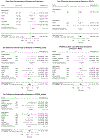Differences in the Presentation and Progression of Parkinson's Disease by Sex
- PMID: 33002231
- PMCID: PMC7883324
- DOI: 10.1002/mds.28312
Differences in the Presentation and Progression of Parkinson's Disease by Sex
Abstract
Background: Previous studies reported various symptoms of Parkinson's disease (PD) associated with sex. Some were conflicting or confirmed in only one study.
Objectives: We examined sex associations to PD phenotypes cross-sectionally and longitudinally in large-scale data.
Methods: We tested 40 clinical phenotypes, using longitudinal, clinic-based patient cohorts, consisting of 5946 patients, with a median follow-up of 3.1 years. For continuous outcomes, we used linear regressions at baseline to test sex-associated differences in presentation, and linear mixed-effects models to test sex-associated differences in progression. For binomial outcomes, we used logistic regression models at baseline and Cox regression models for survival analyses. We adjusted for age, disease duration, and medication use. In the secondary analyses, data from 17 719 PD patients and 7588 non-PD participants from an online-only, self-assessment PD cohort were cross-sectionally evaluated to determine whether the sex-associated differences identified in the primary analyses were consistent and unique to PD.
Results: Female PD patients had a higher risk of developing dyskinesia early during the follow-up period, with a slower progression in activities of daily living difficulties, and a lower risk of developing cognitive impairments compared with male patients. The findings in the longitudinal, clinic-based cohorts were mostly consistent with the results of the online-only cohort.
Conclusions: We observed sex-associated contributions to PD heterogeneity. These results highlight the necessity of future research to determine the underlying mechanisms and importance of personalized clinical management. © 2020 International Parkinson and Movement Disorder Society.
Keywords: Parkinson's disease; gender; sex; dyskinesias; cognitive impairment; activities of daily livings.
© 2020 International Parkinson and Movement Disorder Society.
Conflict of interest statement
Figures


Comment in
-
Sex Differences in Parkinson's Disease Phenotype and Caregiving Disparities.Mov Disord. 2021 Feb;36(2):526. doi: 10.1002/mds.28459. Mov Disord. 2021. PMID: 33599002 No abstract available.
-
Reply to: 'Letter to the Editor on "Sex Differences in Parkinson's Disease Phenotype and Caregiving Disparities"'.Mov Disord. 2021 Feb;36(2):527-528. doi: 10.1002/mds.28456. Mov Disord. 2021. PMID: 33599005 No abstract available.
References
-
- Picillo M, Nicoletti A, Fetoni V, Garavaglia B, Barone P, Pellecchia MT. The relevance of gender in Parkinson’s disease: a review. J Neurol 2017;264:1583–1607. - PubMed
-
- Georgiev D, Hamberg K, Hariz M, Forsgren L, Hariz G-M. Gender differences in Parkinson’s disease: a clinical perspective. Acta Neurol Scand 2017;136:570–584. - PubMed
-
- Locascio JJ, Corkin S, Growdon JH. Relation between clinical characteristics of Parkinson’s disease and cognitive decline. J Clin Exp Neuropsychol 2003;25:94–109. - PubMed
Publication types
MeSH terms
Grants and funding
- M01 RR000645/RR/NCRR NIH HHS/United States
- M01 RR000034/RR/NCRR NIH HHS/United States
- Z01 AG000949/ImNIH/Intramural NIH HHS/United States
- U01 NS100603/NS/NINDS NIH HHS/United States
- M01 RR000334/RR/NCRR NIH HHS/United States
- P50 AG005134/AG/NIA NIH HHS/United States
- U19 AG062418/AG/NIA NIH HHS/United States
- M01 RR000042/RR/NCRR NIH HHS/United States
- U01 NS043128/NS/NINDS NIH HHS/United States
- R01 NS115144/NS/NINDS NIH HHS/United States
- M01 RR000040/RR/NCRR NIH HHS/United States
- M01 RR000036/RR/NCRR NIH HHS/United States
- U01 NS050095/NS/NINDS NIH HHS/United States
- DH_/Department of Health/United Kingdom
- M01 RR000044/RR/NCRR NIH HHS/United States
- M01 RR000059/RR/NCRR NIH HHS/United States
- R01 NS024778/NS/NINDS NIH HHS/United States
- U01 NS082157/NS/NINDS NIH HHS/United States
- M01 RR001066/RR/NCRR NIH HHS/United States
- M01 RR000827/RR/NCRR NIH HHS/United States
- M01 RR000847/RR/NCRR NIH HHS/United States
LinkOut - more resources
Full Text Sources
Medical

